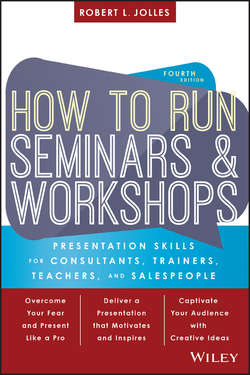Читать книгу How to Run Seminars and Workshops - Jolles Robert L. - Страница 7
На сайте Литреса книга снята с продажи.
PART I
GETTING STARTED
CHAPTER 1
CREATING A SEMINAR BUSINESS
Branding Yourself
ОглавлениеBefore we start working on putting participants into the seats, referred to as “populating the room,” you must figure out what these participants are coming to hear. The concept of branding yourself sounds a little rough, but not to worry. It isn't as bad as it sounds. You see, rarely are you the only person on the face of the earth who will be talking about the subject you profess to be an expert in. The term “branding” refers to how you will differentiate yourself within your industry.
For instance, there are many who lecture on selling, one of the topics I lecture on. Go to the bookstore and you will notice that there are a few people who claim to know as much, if not more, than I do. However, my branding has been threefold:
1. I teach a classic Xerox sales approach.
2. I teach from “repeatable, predictable processes.”
3. I teach the art of creating urgency.
This becomes my branding, or my niche. It allows clients to differentiate what I do from what others do. It might differentiate me into a job, or it might differentiate me out of a job. Clients can decipher what makes me unique.
What will be your branding? It may be one of the most important questions you ask yourself. Do not rush into a quick answer. In a sense, you may be married to this concept for quite some time. Whatever you decide, I suggest you follow a couple of simple rules.
Rule #1 – Think Outside of the Box
That can be a tired phrase, but the fact of the matter is that many geniuses of today are working with ideas that have been around for quite some time. What initially makes them different and employed is the creativity they use to attract their clients.
One of my colleagues, Eric Hargens, works with salespeople as well. He's spent time as a consultant and sales manager, and he struggled with this for a while. He wanted to focus on the initial conversation that goes on between client and salesperson. That doesn't sound much like a branding, now does it? After a few long walks and a couple of cigars, he came up with a different way of articulating this concept. He calls it “the art of chitchat.” Now he has a simple way of explaining what makes what he does unique. That's what I call thinking out of the box.
Rule #2 – Keep It Simple
I hear from many people working on their consulting businesses who are trying to brand themselves. When I ask them what they speak on, often the next sentence out of their mouths tells me all I need to know.
When I hear someone take five minutes to answer the question, there is a problem. If you can't explain it, how in the world are you going to sell it? Most people are not interested in hearing a dissertation or pieces of your seminar. They just want to know what you are going to teach them. My rule of thumb is simple: If it takes you more than five words to say it, it's not simple enough.
Please understand that “simple” doesn't mean “obvious.” “Simple” means “easy to understand.” My suggestion is to write out and practice little sound bites that would interest prospective clients.
Rule #3 – Don't Underestimate the Basics…Just Don't Advertise It!
Now that you will be thinking out of the box and trying to keep the concept simple, you are probably asking yourself, “How do I come up with the next hula hoop?” You don't have to. You need to put your own slant on your topic and surround it with solid presentation skills that you will learn in abundance as you read through this book. If it were me, I'd start with the basics.
When I left Xerox and started my consulting business, I felt I was on the cutting edge of every process that related to selling. During one of my seminars an individual came up and complimented me on how I was defining the art of selling. I wasn't that surprised because I felt this was one of the most unique definitions I had created.
He then told me he had seen a similar definition in a book he had read. I was flabbergasted and immediately challenged him to give me the name of the book. I had read plenty of books and had never seen anything close to my definition. The book he was quoting was Salesmanship and Sales Management, written by John G. Jones from the Alexander Hamilton Institute. Jones's definition of selling went this way:
Salesmanship, in its broadest sense, is essentially the selling of one's point of view – the ability to start with the other fellow's point of view and to lead his mind to the viewpoint of the seller.
I must apologize for the indifference to gender within Jones's definition, but that is how they referred to many things in 1917, when this passage was written. You see, this is not new information; this is information that has been around…it has simply been forgotten.
Rule #4 – Be Passionate
The quickest way out of the seminar business is to lack passion for the topic you are building your business around. Experience is very important, but experience can be attained. Passion cannot be attained. It must be felt.
What do you truly love to study and talk about? You and your topic are going to be together for quite some time; my suggestion is to think long and hard about this. You and your audiences will be a lot happier if you do!
